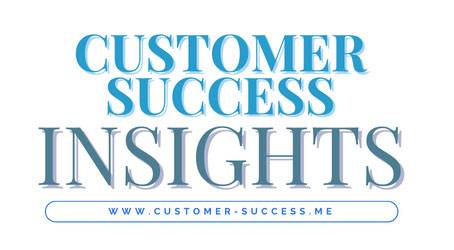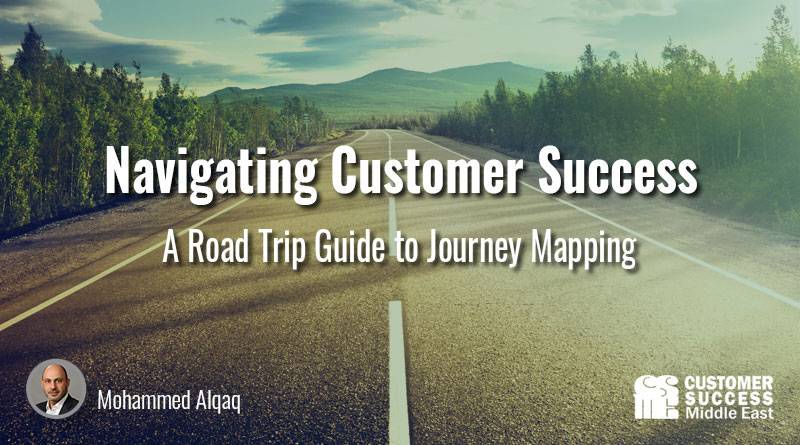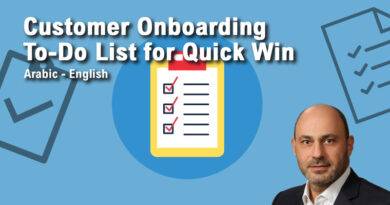Navigating Customer Success – A Road Trip Guide to Journey Mapping
Navigating Customer Success
A Road Trip Guide to Journey Mapping
By: Mohammed Alqaq
Imagine embarking on a road trip. You have a clear destination in mind, a well-planned route, and multiple checkpoints along the way. Some days you might cover more ground than expected, while others might require unexpected detours or longer stops. This is remarkably similar to how a customer success journey map works.
Just as a road trip requires careful planning, navigation tools, regular check-ins at rest stops, and the flexibility to adjust and change routes when needed, a customer success journey follows a similar pattern. Your customers, like travelers, start their journey with specific goals (their destination) and rely on your guidance and support (their navigation system) to reach their desired outcomes.
The parallel becomes even more apparent when considering how both journeys progress. Like how a road trip’s success isn’t merely about reaching the destination but also about the experiences and memories gathered along the way, customer success isn’t just about achieving immediate goals. It’s about creating valuable experiences, learning from challenges, and building lasting relationships that pave the way for future journeys.
What makes this analogy particularly powerful is the concept of renewable destinations. While a traditional road trip has a fixed endpoint, a customer success journey map is dynamic, with destinations that evolve and renew annually. Each “arrival” becomes a launching point for the next phase of the journey, creating a continuous cycle of growth and achievement.
Table of Contents
The Essential Components of a Customer Success Journey Map
A customer success journey map is a strategic framework that outlines the various stages and touchpoints in a customer’s relationship with your product or service. It serves as a comprehensive guide that helps organizations understand, plan, and optimize the customer experience from initial engagement through long-term success.
This roadmap is essential for several reasons:
It provides a clear visualization of the customer’s path to value realization
It helps identify potential obstacles and opportunities for improvement
It enables better resource allocation and team coordination
It ensures consistent delivery of customer value at each stage
Let’s explore the key components that make up an effective customer success journey map, starting with understanding what success means from the customer’s perspective.
Understanding Success from the Customer's Perspective
Before creating a journey map, it’s crucial to understand what success means to your customers. This foundational step helps define the ultimate destination of their journey. Consider the following key aspects when defining customer success:
Business Goals: Understanding the customer’s specific business objectives and how your product helps achieve them
Pain Points: Identifying the challenges and problems that led them to seek your solution
Success Metrics: Establishing clear, measurable indicators that demonstrate value realization
Timeline Expectations: Setting realistic timeframes for achieving different milestones
To gather this information effectively:
Conduct detailed discovery sessions with new customers
Create success plans that align with their specific objectives
Document and share these definitions across your organization
Regularly review and adjust success definitions as customer needs evolve
Remember that success definitions may vary significantly between different customer segments, industries, or use cases. It’s essential to maintain flexibility while ensuring each customer has a clear path to their desired outcomes.
Key Lifecycle Stages
Understanding the key lifecycle stages is crucial for several reasons:
Strategic Resource Allocation: Different stages require varying levels of support and different types of resources. Understanding these stages helps organizations allocate their resources effectively.
Proactive Risk Management: Each stage comes with its own set of challenges and potential risks. Knowing these helps teams anticipate and address issues before they become problems.
Personalized Customer Experience: Different customers may progress through stages at different paces. Understanding the stages helps in providing customized support based on where each customer is in their journey.
Let’s examine each stage in detail and understand its significance:
Purchase Stage: This is where expectations are set and initial relationships are formed. It’s crucial to ensure proper alignment between customer needs and product capabilities during this stage.
Onboarding Stage: This is often the most critical period that determines long-term success. A well-executed onboarding process can significantly improve product adoption and customer satisfaction.
Adoption Stage: This is where customers begin to realize value from the product. It’s essential to monitor usage patterns and provide necessary support to ensure optimal utilization.
Retention Stage: This stage focuses on maintaining the relationship and ensuring continued value delivery. Regular check-ins and proactive support are crucial here.
Expansion Stage: As customers grow more comfortable with the product, opportunities for additional value through expanded usage or new features emerge.
Advocacy Stage: Satisfied customers become brand ambassadors, providing valuable testimonials and referrals. This stage represents the highest level of customer maturity.
Team Collaboration and Ownership
Like a road trip needs different specialists (navigator, driver, mechanic), customer success requires coordination across departments.
The success of a customer’s journey heavily depends on seamless collaboration between different departments, each playing a vital role at various stages:
Customer Success Operations: Acts as the central nervous system, coordinating activities and ensuring smooth handoffs between teams
Product Teams: Gather feedback and implement improvements based on customer needs and usage patterns
Technical Support: Provides timely resolution to technical issues, maintaining customer satisfaction
Account Management: Maintains strategic relationships and identifies growth opportunities
What’s crucial to understand is that customer success is not confined to a single department – it’s a company-wide philosophy and responsibility. Every employee, regardless of their role, contributes to the customer’s journey in some way:
Product development decisions impact customer experience
Marketing messages shape customer expectations
Sales conversations set the foundation for long-term success
Finance policies affect customer satisfaction
This collaborative approach requires Clear Communication Channels Ensuring all teams are aligned and informed about customer progress and needs, Shared Metrics defining common success indicators that all departments work towards, Cross-functional Meetings to discuss customer health and strategies, and Unified Customer View as a single source of truth for customer information accessible to all relevant teams
"The biggest mistake companies make is treating customer success as a department, not a company-wide mission."
— Mohammed Alqaq
Measuring Progress and Success
Establishing and monitoring key metrics is fundamental to ensuring customer success and driving continuous improvement. Here’s why these measurements are critical:
Early Warning System: Metrics serve as indicators of potential issues before they become critical problems, allowing for proactive intervention
Data-Driven Decision Making: Quantifiable metrics enable teams to make informed decisions about resource allocation and strategy adjustments
ROI Validation: Clear metrics help demonstrate the value of your product or service to stakeholders and justify continued investment
Key metrics should be tracked across different dimensions:
Product Adoption Metrics: Feature usage rates, active users, engagement levels
Business Impact Metrics: Cost savings, revenue generation, efficiency improvements
Customer Satisfaction Metrics: CSAT scores, support ticket resolution times, customer effort scores
Growth Indicators: Expansion rates, referral rates, upsell opportunities
Best practices for metric tracking include:
Setting clear baseline measurements at journey start
Establishing regular review cycles for metric analysis
Creating automated alerts for metric thresholds
Sharing metric insights across teams to drive alignment
Remember that metrics should evolve as your customer relationship matures and their needs change. Regular review and adjustment of your measurement framework ensures it remains relevant and valuable over time.
Continuous Optimization
The continuous optimization of a customer journey requires regular adjustments for several key reasons:
Evolving Customer Needs: As businesses grow and markets change, customer requirements and expectations evolve, necessitating updates to the journey map
Technological Advancements: New tools and technologies may offer better ways to serve customers and track their progress
Competitive Landscape: Changes in the market and competitor offerings require continuous adaptation of customer success strategies
Internal Process Improvements: Learnings from customer interactions and data analysis often reveal opportunities to streamline and enhance the journey
To ensure effective optimization, organizations should:
Conduct regular journey audits to identify gaps and opportunities
Maintain open feedback channels with customers at all stages
Monitor industry trends and best practices
Document and share successful adjustments across teams
Optimization is not just about fixing problems – it’s about proactively identifying opportunities to enhance the customer experience and deliver greater value.
Remember: The customer success journey is not a one-time trip but an ongoing cycle of growth and improvement, with each renewal marking a new chapter in the customer’s evolving story with your product or service.
The Road Trip Analogy
Just as a road trip has distinct phases and milestones, the customer success journey follows a similar pattern:
1. Planning and Preparation
Like planning a road trip, the initial phase involves:
Defining the destination (customer success goals)
Mapping out key stops (milestone achievements)
Preparing necessary resources (tools and training materials)
Identifying potential challenges (risk assessment)
2. Navigation Tools
Similar to using GPS and maps for a road trip, customer success teams utilize:
Customer success platforms to track progress
Analytics tools to measure engagement
Communication channels to maintain contact
Dashboards to monitor key metrics
3. Pit Stops and Checkpoints
Just as road trips include strategic stops, the customer journey includes:
Regular check-in meetings
Quarterly business reviews
Training sessions
Performance evaluations
4. Course Corrections
Like adjusting your route due to road construction or weather, customer success requires:
Flexibility in approach based on customer feedback
Quick response to emerging challenges
Alternative paths to achieve objectives
Regular strategy adjustments
5. Reaching Destinations and Setting New Ones
Similar to reaching a destination and planning the next trip, customer success involves:
Celebrating achieved milestones
Setting new goals for the next period
Reviewing the journey for improvements
Planning the next phase of growth
The beauty of this analogy lies in its emphasis on continuous progress. Just as each road trip creates memories and lessons for future journeys, each customer success cycle builds upon previous experiences to create more efficient and effective pathways to success.
The Continuous Journey of Customer Success
Now is the perfect time to pause and reflect on your own customer success journey mapping. Ask yourself:
Are your current journey maps accurately reflecting your customers’ evolving needs?
Have you identified all the critical touchpoints where your team can add value?
Do your success metrics align with both your customers’ goals and your organization’s objectives?
Take a moment to evaluate your existing processes. Consider conducting a thorough audit of your customer success journey by:
Reviewing customer feedback and satisfaction scores across different journey stages
Analyzing drop-off points where customers might be struggling
Assessing the effectiveness of your current tools and resources
Gathering input from various teams about potential improvements
Like any well-planned road trip, the success of your customer journey depends on regular maintenance, timely adjustments, and a willingness to explore new routes to reach your destination. Start your evaluation today to ensure you’re providing the best possible path to success for your customers.
Author

Mohammed Alqaq
The Founder of Customer Success Middle Community. 2024 Top 25 Customer Success Influencer, 2023 Top 100 Customer Success Strategists,’ and was nominated as one of the ‘Most Creative Customer Success Leaders in 2023 & 2024.’ These recognition's represent not only personal milestones but also a testament to his dedication to redefining customer success. His journey in this field is not just about achieving results, but also about creating meaningful, long-lasting experiences that drive business growth.

Stay ahead of the game.
Sign up to the newsletter.
Get all the hottest customer success conversations and talking points landing in your inbox once a month, every month.




